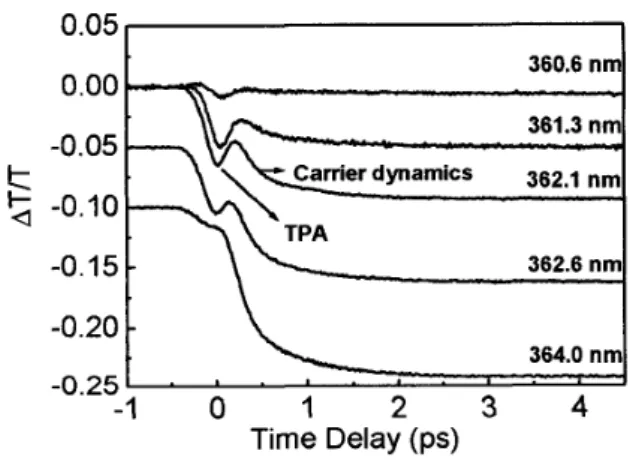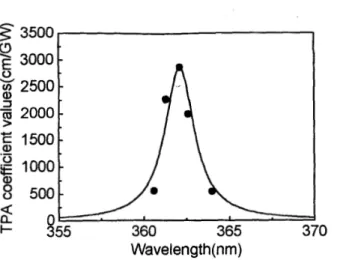QTuJl
Observation of huge nonlinear absorption enhancement
near exciton resonance in
GaN
Kung-Hsuan Lin, Gia-Wei Chern, Yin-Chieh Huang, and Chi-Kuang Sun Graduate Institute ofElectro-Optical Engineering ,National Taiwan University, Taipei, I061 7, Taiwan
Phone 886-2-23659703, FAX 886-2-23677467, E-mail jO941009@ee.ntu.edu.t~ Stacia Keller, Umesh Mishra, and Steven P. DenBaars
Department ofElectrical and Computer Engineering, University of Calfornra, Santa Barbara, CA 931 06 Abstract: Huge nonlinear-abso@ion enhancement was observed in GaN system at the excitonic
transition wavelength. This excitonic enhancement is attributed to four-wave-mixing type
nonlinear processes. The peak nonlinear coefficient is at least 3000 c d G W corresponding to an enhancement factor of >200. The dephasing time of the exciton was also observed to be 60-160 fs
in GaN thin iilm at room temperature.
02003 Optical Society of America
OCIS codes: 190.4720 Optical nonlinexities of condensed matter; 190.41 80 Multiphoton processes. 1. Introduction
In th s paper, we repott the first observation of huge resonance of TPA coefficient near exciton resonance in semiconductor ever. This excitonic enhancement is not just attributed to four-wave-mixing (FWM) type nonlinear processes, but also due to the large exciton binding energy in GaN.
2. Sample and Experimental setup
To study the TPA with the excitation near the bandgap, we performed UV pump-probe experiments on the 2.5 pm
thick undped GaN and observed the sigruficant enhancement of TPA.
3. Experimental results
Fig. 1 shows the typically measured probe transmission change ATIT of the nominally undoped GaN thin film as a function of probe delay at dtfferent central wavelengths near the exciton resonance photoexcitation. The gaussian-
ltke component of the traces at zero time delay is contributed by the TPA process. The traces also reveal that the
processes of excitons ionization and free carriers thermalization were 100 - 250 fs and 600 - 800 fs, respectively. The detail of the fast carriers dynamics were discussed in our previous studies [l]. The magnitude of the TPA
component is obviously enhanced near the photoexcitation of 362 nm, which is very close to the exciton excitation energy in our sample.
4. Discussion
By assuming the pulse is gaussian-shaped in time and the beam is also gaussian-shaped in space, a TPA coefficient
value
p
can be estimated asa is the linear absorption coefficient and I, is the effective intensity of the pulse. The TPA coefficient values with
different central wavelengths are showed in Fig. 2. For example, at a wavelength of -362 nm, a TPA coefficient
value of 2900 c d G W can be obtained, which is much lugher than the already high below-bandgap TPA coefficient
value of 15 c d G W at 400 nm [2].
To explain the enhancement of the TPA coefficient values near exciton resonance frequency, we considered a simplified three levels system. The system is initially in the ground state Ig) with no excitons, and the final state
I
f)
is the elctron-hole pair state. For the intermediate states, we assume that the contribution of the bandtail states is small and only take the exciton state In) into consideration The relation between the TPA coefficient and theQ T u J l
0.00 1 K -ywhere ong is the exciton resonance frequency and
rtlg
is the dephasing term. The fitting results are also shown in fig. 2. An exciton dephasing time-
66 fs can be obtained. If we use a Lorentzian function convolved by the laser spectrum, the dephasing time is-
155 fs. This results show that the room tempemture dephasing time of excitons is close to the exciton ionization time of-
200 fs.5. Summary
We have observed the enhancement of nonlinear absorption near exciton resonance in GaN thin films using femtosecond pump-probe techniques. The TPA coefficient values of GaN near exciton resonance are at least 3000
cm/GW, and the dephasing time is 60-160 fs at room temperature. Detailed analysis and discussion will be presented in the talk.
6. References
[l] Y. -C. Huang, et al., ”Femtosecond dynamics of exciton bleaching in hulk GaN at room temperature,” Appl. Phys. Lett. 81,85 (2002). [2] C. -K. Sun, et al., “Two-photon absorption study of GaN,” Appl. Phys. Lett. 76,439 (2000).
360.6 nm ’
\+-
361.3 nm Carrier dynamics 362.1 nm5
-0.10t
-0.15 -0.20-
-0.25 364.0 nm 2 3 4.
.
’ . ‘ . ’ . ‘- -1 0 I Time Delay (ps)Fig. 1. Measured probe transmission transient response of the nominally undoped GaN thn film as a function of prohe delay at different central wavelengths near the exciton photoexcitatioi~.
QTuJl
3000
-
2500
-
2000
-
1500
-
1000
-
500
-
3500
+
i
Wavelength
(nm)
Fig. 2. The solid circles are the TPA coefficients calculated from the measured traces near the exciton resonance, and the solid line is the Lorentzian fitting curve.

